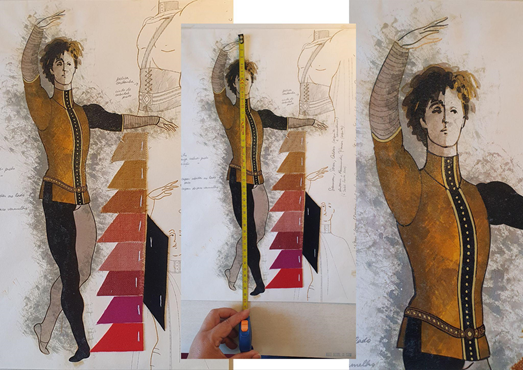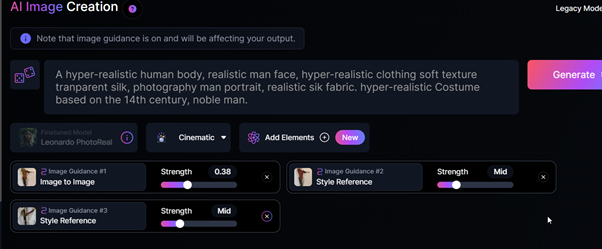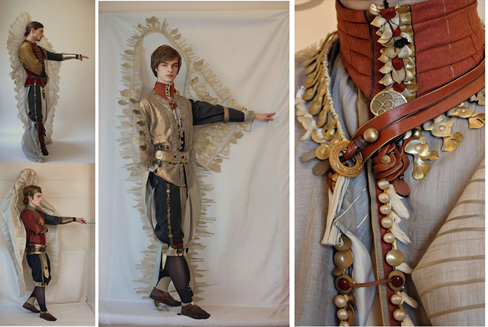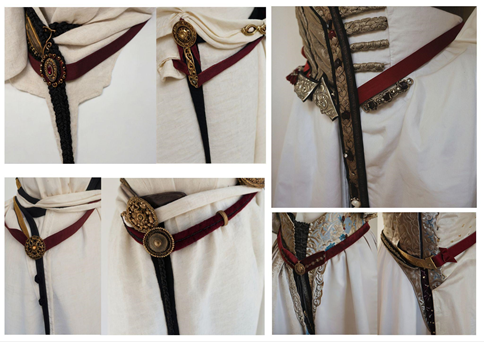Journal of
eISSN: 2574-8114


Mini Review Volume 11 Issue 1
Faculdade de Belas-Artes, Universidade de Lisboa, Portugal
Correspondence: Michele Augusto, Universidade de Lisboa, Faculdade de Belas-Artes, Centro de Investigação e de Estudos em Belas-Artes (CIEBA), Largo da Academia Nacional de Belas-Artes, 1249-058, Lisboa, Portugal, Tel (+351) 912839456
Received: December 21, 2024 | Published: January 10, 2025
Citation: Augusto M. From the collection to the digital stage: creative processes based on the Museu do teatro e da dança archieve. J Textile Eng Fashion Technol. 2025;11(1):15-19. DOI: 10.15406/jteft.2025.11.00398
This article outlines the process of integrating theoretical and practical research in the performing arts, with a specific focus on costume design. It aims to illustrate instances where creative action is combined with qualitative research. This is achieved through the development of costume designs using digital tools and iconographic data from the historic costume design collection at the Museu Nacional do Teatro e da Dança (MNTD) of Portugal. The practice-based research method involves creating variations of shapes or digital collages on bodies, utilizing the visual and textual documents from the museum's archives, along with technological resources for image editing and artificial intelligence generators for creative composition. The goal is to produce diverse forms from the same original design information, thus generating a range of options for new costume creations. This research experimentation seeks to analyze how identical parameters can yield new results derived from scenic memory data without simply replicating them. The outcomes include the presentation of elements combined into new formal models for the same character or serving as inspiration for another character with a similar symbolic or epic foundation. Furthermore, the research aspires to foster future creative processes that utilize the collections as primary sources. It aims to promote exhibitions that blend these sources with new montages and emphasize the various stages of the creation process. This approach aims to highlight the importance of scene design elements and the overall structure involved in crafting a character's costume, including both formal aspects and associated symbols.
Keywords: pratice-based research, costume design, artificial inteligence & digital images, cultural heritage, Museu Nacional do Teatro e da Dança
The performing arts encompass a multi-plural construction of combined visual and sensory elements, including spatial dynamics, lighting, costumes, and choreography, all of which shape an actor's physicality and interpretation of a character. This essay examines the impact of costume on the actor's portrayal, whether in musical performances, dance, or narrative forms such as plays, operas, and films.
Costumes play a crucial role in constructing identity, personality, feelings and emotions, geographic and temporal location, and cultural, social and political contexts, serving as symbolic codes that enhance the narrative.
Each element of costume design is intentional, conveying specific messages through visual composition. The costume functions as an “extra-daily event”,1 embodying the act of appearance and serving the performance’s intent.
Historically, costumes have guided audience interpretation and contributed to character development, adapting to the body’s movements in each production. Stage productions undergo several developmental stages, including text adaptation, spatial planning, character personality definition, and the establishment of dress codes during pre-production. Once these elements are defined, the production moves into set design and costume creation, bringing the symbolic atmosphere to life through rehearsals until the premiere.
Costume illustrations belong to the pre-production stage of scene design. The drawings make up the primary symbolic construction of the character. The character's identity corpus is formed from the sketches and compositions of ideas. We can think of this phase based on the concept of body assemblage,2 in which different signs are combined by overlapping layers in the reference sketches and collages that configure the set of costumes of a given character.
The costume thinking process is collage type, a versatile art form that accommodates multiple texts and visuals in a single work, it´s a field of “multimodal research”.3 They are ideas and forms aimed at a specific functionality to serve the performative context for which it is intended.
With this, each costume created is connected to the intention of the narrative. while fashion seeks a broader appeal, which encompasses a general and collective context to suit different bodies and behaviours, the costume encompasses a particular and individual context to suit a specific body (or bodies) and behaviour.
By observing the attributes of stage design, we highlight the relevance of museum collections as sources of inspiration and research since the memory preserved through fragments and records of the shows keeps the creative flame alive. Looking at what the production helps to guides to new creative perspectives, whether by forming new ideas or by maintaining signs already consolidated over time. After all, each production generates a memory of a collective imagination. It is up to the designer to use or not these stage memories established codes.
From the collection
The collection of the Museu Nacional do Teatro da Dança allows stage researchers to engage with fragments of diverse productions and identify points of convergence and divergence in each production of the same title or theme. In this way, a set of information useful to the creative process can be prepared. Each element is separated and connected according to the stage's intention and need.
The collection includes texts, dramatic programs, images and newspaper clippings, sound and video recordings, scenographic and costume elements, etc. Within this set was selected the collection of stage costumes and costume designs for the case study of this essay.
The goal is to demonstrate ways of combining stage memory with new creations and analyze how creative costume processes can be enriched by historical elements (such as the MNTD collection) and technological tools (such as artificial intelligence and digital art) combination.
Our hypothesis is to conduct a more detailed study of the iconographic data generated from the original drawings and technical sheets, combined with the capacity of digital art to generate new images from specific parameters, with the intention of demonstrating the capacity to create costumes from collective memory, offering new perspectives and aesthetic solutions.
The MNTD is responsible for preserving and promoting the performing arts memories in Portugal. The museum's collection covers a wide range of documents related to the work of performing arts professionals. The collection is divided into three categories:
The costume design drawings fall under the first category: objects reflecting artistic practice. The MNTD costume collection consists of approximately 8,200 pieces, including around 6,200 costumes and 2,000 drawings.5 The original drawings vary in size from approximately A6 (e.g., Plate 34162, Pagem de Dunois by Santa Joana) to A2 (e.g., Plate 34280, Egas Moniz by Auto da Fundação). The majority employ gouache, with watercolors and touches of dry pastel and pencil. Most techniques exhibit a traditional approach to light and shadow, texture representation, and decorative elements.
The graphic structure follows the parameters of silhouettes of medieval iconography, according to the main theme of the selected pieces, with relevant emphasis on visual configurations based on the artist's contemporary style, in colour combinations, marking of relief areas and above all the silhouette of the bodies in many cases, as in the works of Abílio de Mattos e Silva.
Theatrical productions of the period followed the modernist style, consecrated as the official style of public policies for Portuguese cultural activities during the Estado Novo; the aforementioned artistic movement permeated both independent productions and those financed by the government. The artistic movements put at the service of the regime through the SPN/SNI action, in which Antônio Ferro devised a program that addressed a cultural project skillfully combining modern aesthetic resources with a nationalist program of reinvention of tradition that far exceeded the internal and external propaganda needs of the Estado Novo.6 The political-ideological program discourse was biased towards nationalist values to convey the great moments in the formation of the nation, the national apogee, and popular and cultural traditions. The artists as scenic creators were responsible for the productions that followed some trends of the avant-garde artistic movements, receiving influences from Modernism, a style implemented as the basis of the "Política de Espírito". The visual aesthetics based on the renewal of national bases, the enchantment scenographic atmosphere creation for the idealized popular imaginary formation of the cultural representation stylized within the plastic modernist shape.
The "Política de Espírito" of Antônio Ferro and António Oliveira Salazar, through the guidelines of the Estado Novo (from 1926 to 1974), strengthened the ideological bases by developing new activities considered as "Política de Espírito", such as the promotion of performing arts, festivities, and activities that represented national cultural and historical activities and facts. To this end, the agencies of the Secretariado da Propaganda Nacional (SPN) | Secretariado Nacional da Informação, Cultura Popular e Turismo (SNI), led by António Ferro, used organizations, sectors, and cultural actions to communicate their ideals through forms of expression.7
In our research, we identified key visual elements essential for developing the inspirational foundation of new costume productions. This applies both to reimagining existing characters and to creating new ones with similar traits. Specifically, the combinations of necklines, cutouts, patterns, silhouettes, embellishments, and graphic textures offer numerous possibilities when integrated with volumetric patterns, colors, and symbols (Figure 1) (Figure 2). These elements suggest layers and overlays that serve as foundational patterns in the creative process for new designs.

Figure 1 (left) MNT 34162 Pagem de Dunois, 10 cm , Santa Joana Play, 1956, Cª Rey Colaço Robles Monteiro, costumes by José Barbosa; (right) MNT 34280 Egas Moniz, 60,7 cm, "Auto da Fundação" de Cª Rey Colaço Robles Monteiro, 1940. Costumes by Maria Adelaide Lima Cruz. (Source MNTD, photos by Michele Augusto).

Figure 2 costumes by Abílio de Mattos e Silva, (left) Leonor Teles play by Teatro Nacional Popular (right) 181598-A Nobres, MNT 181392-A characters by O Condestável Ballet, by Companhia de Bailados Verde Gaio.
Figure 3 and Figure 4 showcase detailed textures representing fabrics and surface treatments, including paintings and embellishments. For instance, the ringed gray sleeve mimics ribs, illustrating the diversity of fabrics within the dancers' ensemble. The pencil sketch proposes various internal garments for potential changes, while the gray background emphasizes the figure and its movement. This composition suggests new designs for capes and cloaks, highlighting the proportions of the illustration.

Figure 3 In: 204605 D. Pedro (Armando Jorge) 1970, Grupo de Bailados Gulbenkian, costume by Artur Casais (Source: MNTD, photo by Michele Augusto).

Figure 4 In: 204602, Fidalgos do Séquito, 1970, Grupo de Bailados Gulbenkian, figurino de Artur Casais (Source: MNTD, fotografia: Michele Augusto).
The creative process: uses of the collection, resources and digital tools
The use of AI and digital image editing enhances the creative process by facilitating speculative exploration in scene design. These technological tools offer a range of variations and combinations, allowing for the interchange of ideas. The variations and possibilities of combinations and layer overlays allow for the interchangeability of ideas. Cutouts of specific fragments and details, openings of areas and insertion of elements, and rotation and insertion of shapes allow for a dynamic formation of costumes and costume accessories on the body structure, associated with the symbolic elements of each character's identity and specificity of the scenic narrative. In Figure 3 and Figure 4 illustrate details of textures that represent fabrics and surface treatments, including a ringed gray sleeve symbolizing ribs and the diversity of fabrics used in the dancers' ensemble. The pencil sketch suggests potential internal garments for quick changes, while the gray background emphasizes the figure and its movement, indicating the formation of capes and cloaks in new designs.
The examples provided (Figure 5) (Table 1) highlight how parameters derived from iconographic descriptions and formal analyses of the original objects in scenic memory can guide the creative process through keywords and selected visual fragments. This approach enables the generation of constructions that, while not initially planned, can evolve into forms better suited to the specific context of a given character. Consequently, employing a methodology of unrestricted random and generative experimentation allows these processes to serve as creative agents in scene design.

Figure 5 Examples of parameters extracted from the museum's original drawings and technical sheets analysis applied to Artificial Intelligence tools. (Own source).
|
204602 Noblemen of the retinue |
|
|
1970, Artur Casais |
|
|
Costume description |
Iconographic description |
|
Dancer in a collant with one dark brown leg and one grey leg. Long-sleeved grey sweater. Over it is a mustard yellow doublet with a dark brown stripe from top to bottom with small yellow buttons. The doublet has elbow-length sleeves and one is mustard yellow and the other dark brown. It has two detailed drawings, notes by the author and 8 fabric samples. |
A costume based on late 14th-century palace attire adapted to the functionality of ballet attire. Short doublet in mustard yellow linen (detail of notes and various samples for each nobleman in the ensemble), with a high collar and black velvet stripe trim with yellow buttons, two-tone ¾ sleeves, black velvet sleeve, gathered white chemise inner sleeve, wide leather belt with buttons and brooch buckle. Leg mesh imitating two-tone trousers in shades of black and grey. Side cape in various colours (notes of details) according to the noblemen in the ensemble. |
|
(Data from the technical file produced by the Museum team, source MNTD) |
Note on the doublet and capes of the noblemen: linen, black velvet sleeve with black velvet appliqué; 6 open capes on the side of the sack, 3 red sack capes. Detail of the cape design on the side. (source: own) |
Table 1 Examples of parameters extracted from the analysis of the museum's original drawings and technical sheets
The methodology of the digital media work, develops a creation mode that combine knowledge and expression “through a conversation between research and practice”.7 The studies based on the characters from the Ballet O Trono shed light on the process of possible plastic variations in the creation of props (Figure 7) (Figure 8), fragments of costumes and sets of finishes that can enrich the process of symbolic construction and the transition to the real object of the stage costume, since the combinations bring new perspectives to embroidery options, application of materials and combinations that allow a better symbolic construction of the character's identity. During the process, images and objects that are part of the set of physical elements combined during the material selection stage can serve as a basis for the digital collage formulation, whether in image editing tools or as keywords generated by AI (Figure 6).

Figure 6 costumes, layers and body-assemblages constructed from the original drawings and data of O Trono Ballet. (Own source).

Figure 7 AI experimentation with variations in decor and adornment of garments in collars and necklines, studies made from the silhouettes, colours and details of the shapes of characters from O trono. (Own source).

Figure 8 AI experimentation with ornaments and embroidery created from details of O trono drawings (Own source).
“The Digital systems are fluid, in that bits can be recycled for use almost indefinitely, and constructible because while their organisation is variable and provisional it is definable by coding in computer programming languages”,8 the fluidity of the dates helps us to get better result on the processes, because we can reuse the same image as foundation and recycling some type of generation more adapted to the real intentionality. As example the Figure 7 was created by the same image but using a second image prompt command we could refine the result, from the entire body of the character was necklines and adornments for decorating the upper torso of a new character with noble features for medieval-inspired ballets.
“The fluidity of digital media means that there can be digital representations of various other media including text, image and sound along with processes for the manipulation of them”,8 we can see this type of information variety through the Figure 5 analysis, every single change of keyword position or type of filters, image guidance values of strength alteration gives completely different image in return. This technical composition of the Artificial intelligence digital art manipulation brings to the works the possibility of creations out of the mind as the artist is used to do, so this method helps the designer to reach new paths of material combinations and changes of the common sense in the performance collective imagination.
Through this essay, we hope to elucidate ways of exploring scenic memory as a research and creation tool and demonstrate how the new and contemporary elements combined in a new costume creation added to inspirations from historical sources and enriched by technology can provide better creative conditions. Through the examples, we can identify the conjunction of these elements on the shape of the performer's body.
Technological resources help costume designers overcome the challenges of creating costumes. The interactions between images, filters, command words (in the case of AI), layer overlays and cutouts, transparencies, effects, backgrounds, base inspiration images, and other resources inherent to the editing and visual creation process enable and facilitate the permeability of ideas and aesthetic possibilities.
The intention was to realize a quick analysis of how the fluidity of combinations based on the image of the scenic memory and its iconographic attributes can generate new insights and options for creative renewal. “The ability for digital systems to enable the articulation of generative processes as a form of meta-creation allows interaction between the expression and exploration of ideas that is fruitful for both creative practice and research endeavours”.8 That ability consciously developed the applicability of materials and types that are essential items in each scenic creation, a specific fabric, a special silhouette, or a crucial prop, but renewing the way these elements are generated. Because of the desired combinations, it is possible to expand the design parameters, taking advantage of the free experimental thinking, the digital system allows. As we can see from the results obtained, from the silhouette of the dancer's body, through the conjunction of the colour masses and position of the form we received a series of forms that can generate options for shapes and finishes of collars of a given group of dancers for a new scenic assembly with aspects like the original. Therefore, historical and iconographic research structured around the desired concept guides the creative fluidity of recycling forms and keywords, because the thinking and experimenting by the digital system acts as references that will be influence behaviours of the real costume system. So the digital experimental research “creates hypothesis, builds trials and judges their success by evaluating the outcomes”8 of the performance collective imagination construction.
We also emphasize the importance of using technology to help preserve and disseminate the historical collection since the broad network of data available for online consultation makes research and articulate possible, and the data is treated qualitatively, with detailed records of enlargements and details of the original drawings, textual documents such as technical and iconographic files with the maximum possible qualitative data, allowing for minimal handling and sun exposure of the fragile artistic objects in the collection. They allow for interactivity with the public through interactive and digital exhibitions in which it would be possible to fully appreciate each set of drawings and their symbolic and plastic content.
However, without failing to mention the ethical character of using cultural heritage consciously during the processes of creating costume design and promoting it in exhibitions, regarding the importance of due credit to the sources identified in the archives and also for new costume creations, the preservation of the entire form would configure a character of copying the memory of another creator thus the originality of a scenic object has as its criterion the use of parts of the historical object to inspire a new form of an unprecedented character, even if similar forms used, as they feed on signs of the same imaginary.
Therefore, we can see that the combination of technological resources and the digital use of historical collections can bring benefits to researchers of artistic practice and museology teams since the means of displaying qualitative data through broad and public digital means allows for a greater reach of the collection's dissemination in joint actions with designers, who, based on their creative construction methods, record this interaction of using the database with originality.
Through the methodology of collage of keywords and images, a corpus of infinite creative possibilities can be obtained by each detail explored in the museum's archives, allowing more and more combinations and generation of images, especially when using artificial intelligence technology applied to image generation. In this context, we can obtain more varied and more realistic results, in which designers can ensure better elaborations in the combination of ideas, materials and available collections according to the dramatic intentions of each production. The examples demonstrate the formative capacities in which the association of iconographic and symbolic data is possible in the context of the artistic imagery creation of stage costumes.
Through exhibitions focused on the creative process and the display of the guiding elements of a stage production, especially the pieces of the collection, it is possible to define new methodological paths for both museum scenography and stage design in digital tools usability for multi-plural creation and collaboration.
We intend to use this work to elucidate the benefits of integrating historical archives and modern technologies because despite being a common method for developing period costumes, this practice can be applied in different ways since they are collective creative works and each team and type of format has a different structure (audiovisual, theatre, exhibitions and performances, among others). The combination of historical archives and technology helps in the planning of productions, since “the value of images as evidence for the history of clothing is unquestionable”,9 just as Peter Burke demonstrates that in order to understand the whole of a given period “it is necessary to resort to paintings and engravings, as well as some remaining fashion mannequins”, and with the digital technological device it is possible to better adapt the intention, concept and reality, both in stage productions and in the elaboration of museum exhibitions, which would be of great sensory contribution and appeal to the younger public, the immersive character that digital media can provide in museum environments, which can promote hybrid scenarios (physical and digital elements) of different sensory stimuli to the spectator. We highlight the recommendations for future research directions or actions that foster the permeability of the digital universe with the physical one, and the emergence of new production modalities that contemplate generative fluidity as a method of research and experimentation. We hope this research promotes new works that integrate the hybrid performance scene and forms of displaying creative memory.10,11
Thanks to Grupo de Investigação e Estudos em Ciências da Arte e do Património – CIEBA and Museu Nacional do Teatro e da Dança (MNTD) for their support of this research work. This work is financed by national funds through the FCT – Fundação para a Ciência e a Tecnologia, I.P., under the project UIDB/04042/2020 and PRT/BD/152875/2021.
This work is financed by national funds through the FCT – Fundação para a Ciência e a Tecnologia, I.P., under the project UIDB/04042/2020 and PRT/ BD/152875/2021.
The authors declare that there exists no conflict of interests.

©2025 Augusto. This is an open access article distributed under the terms of the, which permits unrestricted use, distribution, and build upon your work non-commercially.